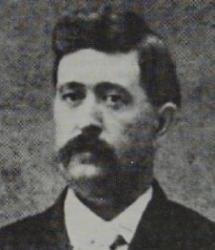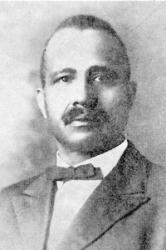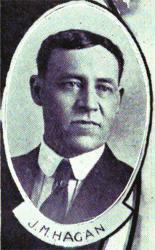Planning worship?
Check out our sister site, ZeteoSearch.org,
for 20+ additional resources related to your search.
- |
User Links
Person Results
‹ Return to hymnal





Export as CSV
Tom Jones
1891 - 1978 Person Name: Rev. Tom Jones Hymnal Number: 199 Composer of "[Let the beauty of Jesus be seen in me]" in Pentecostal Jewels Tom Jones was born in Filey, Yorkshire. In the pre,WW2 years he travelled extensively as an itinerary evangelist. His gift of song was used to lead many to Christ. Later he founded Beeston Nottingham Evangelical Free Church.
Philip Ward (email to Hymnary)
Tom Jones
George R. Farrow
Person Name: G. R. F. Hymnal Number: 2 Author of "All in Him" in Pentecostal Jewels
George R. Farrow
J. W. Dennis

1866 - 1947 Hymnal Number: 163 Composer of "[They tried my Lord and Master]" in Pentecostal Jewels Born: October 8, 1866, Lebanon, Missouri.
Buried: Erick, Oklahoma.
J. W. Dennis
S. H. Bolton
1860 - 1925 Hymnal Number: 8 Harmonizer of "[Jesus has a table spread]" in Pentecostal Jewels Probably Samuel Henry Bolton, brother to Frances Eugenia Bolton
Dianne Shapiro from findagrave.com, accessed 9/15/2024
S. H. Bolton
Samuel Stennett

1727 - 1795 Hymnal Number: 143 Author of "The Promised Land" in Pentecostal Jewels Samuel Stennett was born at Exeter, in 1727. His father was pastor of a Baptist congregation in that city; afterwards of the Baptist Chapel, Little Wild Street, London. In this latter pastorate the son succeeded the father in 1758. He died in 1795. Dr. Stennett was the author of several doctrinal works, and a few hymns.
--Annotations of the Hymnal, Charles Hutchins, M.A. 1872.
======================
Stennett, Samuel, D.D., grandson of Joseph Stennett, named above, and son of the Rev. Joseph Stennett, D.D., was born most pro;bably in 1727, at Exeter, where his father was at that time a Baptist minister. When quite young he removed to London, his father having become pastor of the Baptist Church in Little Wild Street, Lincoln's Inn Fields. In 1748, Samuel Stennett became assistant to his father in the ministry, and in 1758 succeeded him in the pastoral office at Little Wild Street. From that time until his death, on Aug. 24, 1795, he held a very prominent position among the Dissenting ministers of London. He was much respected by some of the statesmen of the time, and used his influence with them in support of the principles of religious freedom. The celebrated John Howard was a member of his congregation and an attached friend. In 1763, the University of Aberdeen conferred on him the degree of D.D. Dr. S. Stennett's prose publications consist of volumes of sermons, and pamphlets on Baptism and on Nonconformist Disabilities. He wrote one or two short poems, and contributed 38 hymns to the collection of his friend, Dr. Rippon (1787). His poetical genius was not of the highest order, and his best hymns have neither the originality nor the vigour of some of his grandfather's. The following, however, are pleasing in sentiment and expression, and are in common use more especially in Baptist congregations:—
1. And have I, Christ, no love for Thee? Love for Christ desired.
2. And will the offended God again? The Body the Temple of the Holy Ghost.
3. As on the Cross the Saviour hung. The Thief on the Cross.
4. Behold the leprous Jew. The healing of the Leper.
5. Come, every pious heart. Praise to Christ.
6. Father, at Thy call, I come. Lent.
7. Great God, amid the darksome night. God, a Sun.
8. Great God, what hosts of angels stand. Ministry of Angels.
9. Here at Thy Table, Lord, we meet. Holy Communion.
10. How charming is the place. Public Worship.
11. How shall the sons of men appear? Acceptance through Christ alone.
12. How soft the words my [the] Saviour speaks. Early Piety.
13. How various and how new. Divine Providence.
14. Not all the nobles of the earth. Christians as Sons of God.
15. On Jordan's stormy banks I stand. Heaven anticipated.
16. Prostrate, dear Jesus, at thy feet. Lent. Sometimes, "Dear Saviour, prostrate at Thy feet."
17. Should bounteous nature kindly pour. The greatest of these is Love. From this, "Had I the gift of tongues," st. iii., is taken.
18. Thy counsels of redeeming grace. Holy Scripture. From "Let avarice, from shore to shore."
19. Thy life 1 read, my dearest Lord. Death in Infancy. From this "'Tis Jesus speaks, I fold, says He."
20. 'Tis finished! so the Saviour cried. Good Friday.
21. To Christ, the Lord, let every tongue. Praise of Christ. From this,"Majestic sweetness sits enthroned," st. iii., is taken.
22. To God, my Saviour, and my King. Renewing Grace.
23. To God, the universal King. Praise to God.
24. What wisdom, majesty, and grace. The Gospel. Sometimes, “What majesty and grace."
25. Where two or three with sweet accord. Before the Sermon.
26. Why should a living man complain? Affliction. From this, "Lord, see what floods of sorrow rise," st. iii., is taken.
27. With tears of anguish I lament. Lent.
28. Yonder amazing sight I see. Good Friday.
All these hymns, with others by Stennett, were given in Rippon's Baptist Selection, 1787, a few having previously appeared in A Collection of Hymns for the use of Christians of all Denominations, London. Printed for the Booksellers, 1782; and No. 16, in the 1778 Supplement to the 3rd edition of the Bristol Baptist Selection of Ash and Evans. The whole of Stennett's poetical pieces and hymns were included in vol. ii. of his Works, together with a Memoir, by W. J. Jones. 4 vols., 1824. [Rev. W. R. Stevenson, M.A.]
--John Julian, Dictionary of Hymnology (1907)
Samuel Stennett
Herbert Buffum

1879 - 1939 Hymnal Number: 40 Author of "He Abides" in Pentecostal Jewels Herbert Buffum was born in La Fayette, Illinois 13 November 1879. He became a member of the Methodist Episcopal Church. He started preaching at seventeen years of age. He did city mission work up and down the Pacific Coast and later in small towns in Kansas. He began publishing hymns at the age of eighteen.
Dianne Shapiro, from "The Singers and Their Songs: sketches of living gospel hymn writers" by Charles Hutchinson Gabriel (Chicago: The Rodeheaver Company, 1916)
Herbert Buffum
Charles Price Jones

1865 - 1949 Person Name: C. P. Jones Hymnal Number: 107 Composer of "[When pangs of death seized on my soul]" in Pentecostal Jewels Charles Price Jones born December 9, 1865, near Rome, Georgia. He grew up in Kingston, Georgia, and attended the Baptist church. He was converted in 1884 while living in Cat Island, Arkansas. In 1885 he was called to the ministry and began preaching. In 1888 he attended Arkansas Baptist College and taught school in Grant County, Arkansas. He preached and pastored several Baptist churches. After asking God for a deeper experience of grace and fasting and praying for three days, Jones experienced a closeness with God, and in 1895, along with other Baptist holiness adherents, who taught that a second work of grace can cleanse the Christian of original sin. They started a holiness movement in the Baptist church, and he began teaching holiness in his congregation, Mount Helm Baptist Church in Jackson, Mississippi. He faced much opposition from some members of his congregation and other Baptist churches. Eventually the church voted to remove "Baptist" and change it to "Church of Christ." For several years, Jones led a non-denominational holiness movement. In 1899 he began to write songs for his church. Most of his hymns were inspired by a scripture passage. The congregation built the Christ Temple campus which included a 1000 seat sanctuary, a printing press, a school building, and a girl's dormitory. In 1917, Jones organized Christ Temple Church in Los Angeles and moved the printing press there. He died January 19, 1949 in Los Angeles
Dianne Shapiro, from Church of Christ (Holiness) U.S.A. website and "Charles Price Jones (1865-1949) Religious Leader" by David Daniels, Mississippi Encyclopedia website (both accessed 10/9/2020)
Charles Price Jones
Miriam E. Oatman
1887 - 1987 Hymnal Number: 86 Author of "The Son Hath Made Me Free" in Pentecostal Jewels Miriam Oatman was the daughter of Joseph Oatman, Jr. and married Frederick F. Blachly. She was a political scientist and served on the Brookings Institution from 1925 to 1933 and taught political science and economics at the American University Graduate School in the 1930’s, and 1940’s. She also wrote over three hundred hymns and composed the music to several of her father's hymns. "How the Fire Fell" is perhaps the most widely known.
Miriam E. Oatman
William Miller
1801 - 1878 Person Name: Wm. Miller Hymnal Number: 112 Composer of "[My heav'nly home is bright and fair]" in Pentecostal Jewels
William Miller
J. M. Hagan

1858 - 1933 Hymnal Number: 70 Composer of "[I have heard of a land]" in Pentecostal Jewels DEACON JAMES MONROE HAGAN: Professor J. M. Hagan, as he was affectionately known, was born in Monroe County, Kentucky, on February 25, 1858, and was the son of James Fendel and Sarah Strode Hagan. He was reared under the most difficult circumstances but was able to work his way through the meager common schools, college and university. He followed the profession of teaching all of his life. His principal teaching was in High Schools in Warren, Munroe [sic], Metcalf [sic], Hart, and Daviess Counties, in Kentucky. He was head or joint head in Munroe [sic] Normal for many years located at Flippin, Kentucky; with Professor T. C. Gillianwaters. Altogether he taught for forty years.
Mr. Hagan married Miss Ella B. Evans of Tompkinsville, Kentucky, in 1892. One daughter, who died early in life, and one son, blessed this union. After the death of his first wife he married Miss Rubye Vance of Paducah, Kentucky, in 1907. Three sons, all of whom are now in the armed forces, blessed this second union.
He was an outstanding musician, receiving his musical training in Tompkinsville, Bowling Green Normal, Moody Bible Institute, and the Cincinnati College of Music. His first musical composition was written at the age of sixteen and over 800 of his hymns were published. He also edited two public school song books and was very active in putting music into the public schools. He taught countless numbers to sing and was associated with such authors as Bliss, Stebbins, Rodeheaver, Coleman, Showalter, Vaughn Brothers and others. For about five years he traveled with an outstanding male quartet.
He was converted at the age of fourteen and united with a Baptist Church. After holding membership in the Bowling Green and Owensboro First Churches for years he spent his last days in the Seven Hills Church where he served as Deacon, Sunday School Teacher, and Choir Director. He died in Owensboro, Kentucky, on January 25. 1933, and is buried here. This good man was Munroe [sic] County's greatest gift to the world.
from "A HISTORY OF THE DAVIESS-McLEAN BAPTIST ASSOCIATION IN KENTUCKY, 1844-1943" by Wendell H. Rone.
J. M. Hagan


 My Starred Hymns
My Starred Hymns


